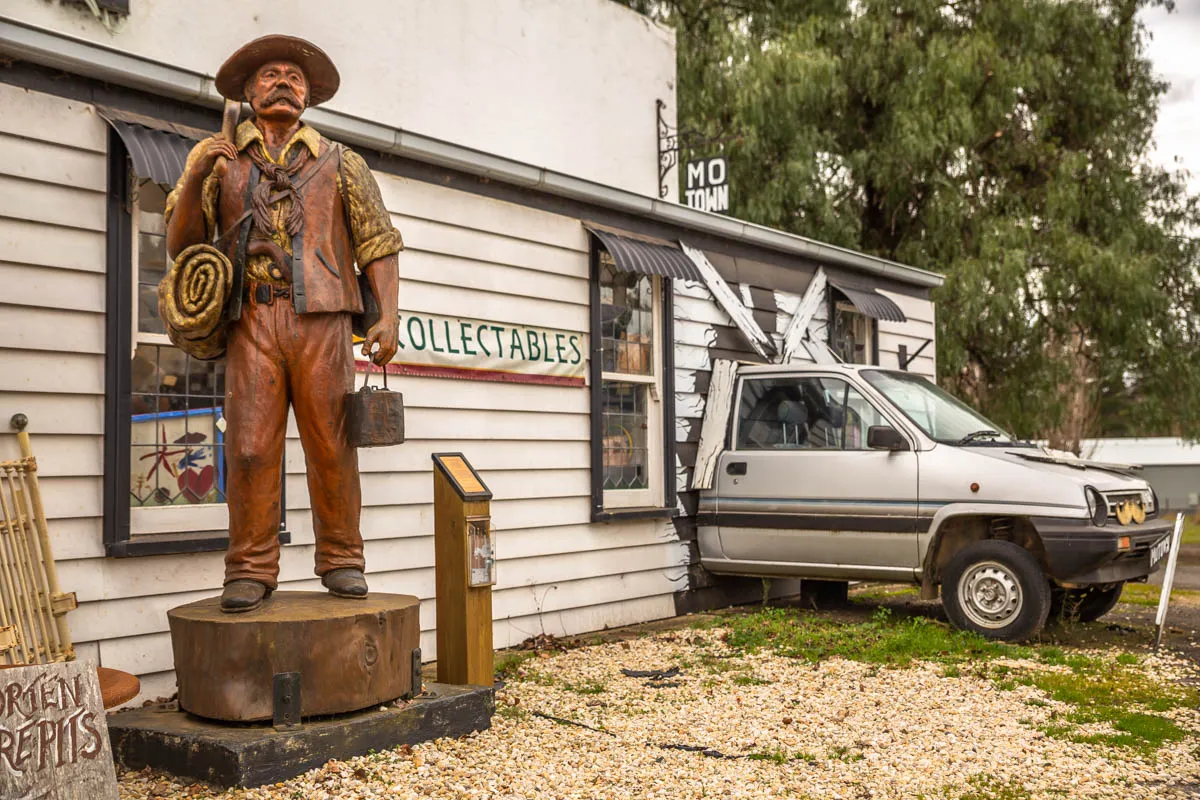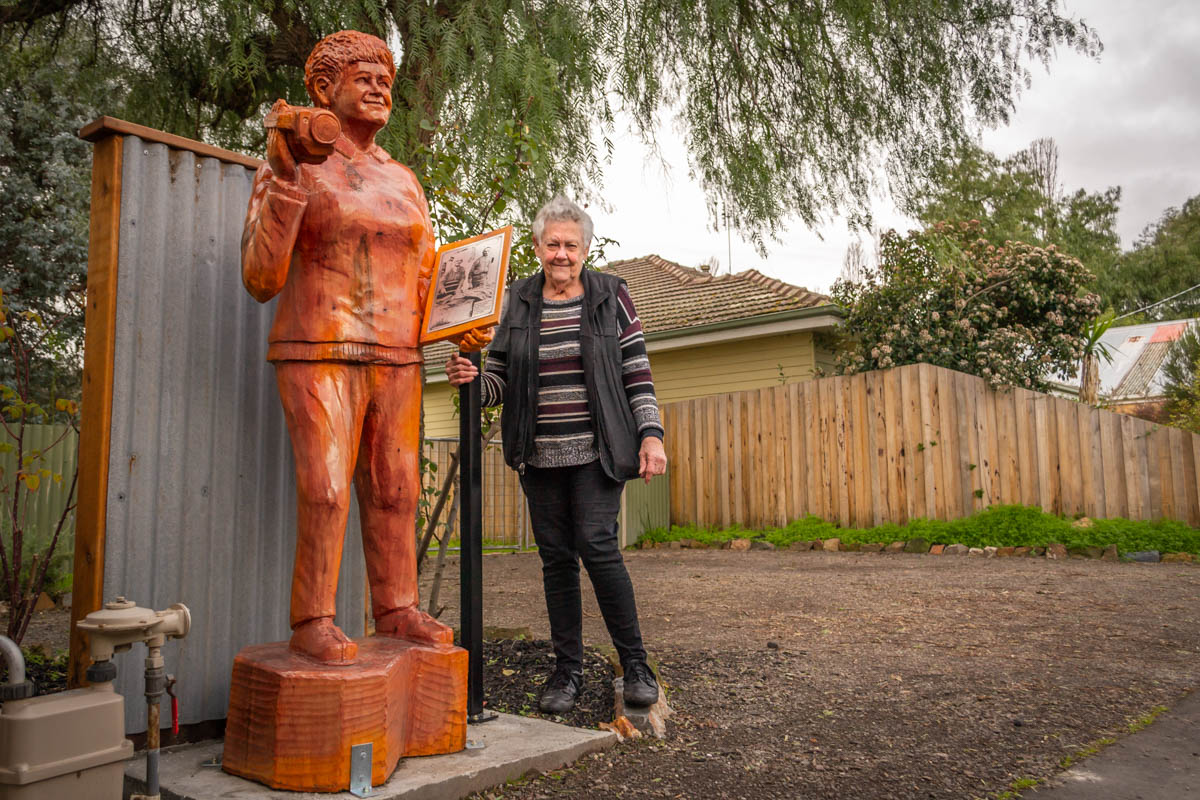
The remarkable Chewton Sculpture Trail is set along Main Road through Chewton and brings a collection of the town's fascinating stories to life!
These brilliant life sized sculptures celebrate the town's rich past and present, telling stories of unforgettable local personalities and incredible events.
"Mo the Miner" celebrates the rich history of the famous Forest Creek (now Chewton) goldfield, the richest shallow alluvial goldfield the world has ever seen, and the thousands of people who journeyed here to seek their fortunes!
A sculpture of Mrs Frances White sits on a charming stone fence, a plaque telling the story of how she experienced a miraculous escape from death when an old mine shaft opened up beneath her feet in 1948!
Formerly known as Forest Creek, Chewton has such a rich and fascinating history to share, being one of the earliest, most important, and renowned goldfields of the 1850s gold rush.
There are six fantastic sculptures to discover (so far), and all are located along Main Road, Chewton. The sculptures begin near the Post Office and Town Hall, and end at Rod Hadfield's hot rod museum just out of town.
This sculpture trail is a labour of love and a work in progress, made possible by the effort and dedication of the Chewton community. There are plans for more sculptures and stories to be added in the future, and we can't wait to see which story will be depicted next in this wonderful series!
The sculptures
Mo the miner

Drop in at Mo's Antique Store in Chewton and check out this life-sized wooden sculpture, one of several in a fascinating series along the town's Main Road.
This sculpture of an 1850s gold miner celebrates the rich history of the Forest Creek (now Chewton) goldfield, the richest shallow alluvial goldfield the world has ever seen, and the thousands of people who journeyed here to seek their fortunes!
The sculpture forms part of a brilliantly quirky creative installation outside Mo's Antique Store, where you will also see a car which appears to have crashed through the wall from within the building.
Frances White

Mrs Frances White, depicted by this gorgeous life-sized wooden sculpture, experienced a miraculous escape from death when an old mine shaft opened up beneath her feet in 1948!
Mrs White lived next door to this sculpture at 153 Main Road, in what was formerly the Francis Ormond Mine manager's house. While speaking with her neighbour near the back fence, the ground gave way beneath her feet as an old mine shaft suddenly opened up without warning!
She managed to grab hold of a branch and found herself hanging precariously at the edge of an 80ft deep hole.
Alice Dennis

This beautiful sculpture of the late Mrs Alice Dennis commemorates the life and achievements of this well known and loved local woman.
Depicted with a friendly smile, Alice waves to passers-by along Main Road while holding a stack of Tupperware containing her famous cakes and treats. Alice was a local treasure who was deeply dedicated to her family and the Chewton Community.
Robert Penney the baker

Born in 1848 and arriving here at the goldfields in 1854, Robert Penney was Chewton's 'Bread & Biscuit Baker, Confectioner & General Grocer' for almost half a century!
This outstanding sculpture depicts Penney standing at a counter with bread loaves beside him and groceries for sale on the wall behind him. Penney operated his business from the brick building to the right of the sculpture, formerly known as "Manchester House".
Rod Hadfield

This brilliant sculpture of local hot rod legend Rod Hadfield stands alongside the Pyrenees Highway in Chewton. Hadfield is depicted here in an early 20th century style garage with his beloved dog Cody and a Ford Model T, a fantastic installation welcoming visitors along the highway into town!
This impressive scene is set at the entrance to the Hadfield's property and renowned hot rod collection, and is well worth dropping by for a look.
Elaine Appleton

Stop by for a look at this amazing sculpture of local historian and treasure, Elaine Appleton! This wooden sculpture celebrates Elaine's unrivalled dedication and contributions over the years to the preservation of her community's local history.
Elaine has worked tirelessly for many decades, compiling and collating local photographs, news articles, and information and donating them to the local community. One of her many valuable projects is her collection of filmed interviews with "old timers" years ago, which provide a remarkable insight into the area's history which would otherwise have been lost.
The sculpture of Elaine was unveiled along Main Road in Chewton in 2022, an event which was well attended and celebrated by the local community.
Elaine regularly shares fascinating local photographs, articles and information to the brilliant Facebook group, Friends of Wattle Gully and Chewton. This group is one of the best local history pages in the Victorian Goldfields and is well worth checking out.
The sculptors
Richard Yates
Richard Yates is a talented local artist who was privately commissioned to create five out of the six sculptures in the Chewton Sculpture Trail:
Born and raised in Wyoing USA, Richard Yates moved to Australia with his family in 2002.
In 2005, he dragged a fallen poplar tree into his shed and tried his hand at carving. Since then, what started as a hobby has developed into a passionate love of creating!
Yates designs and creates realistic sculptures, relief carvings and functional art, working with wood, metal and bronze. He has a talent for breathing life into his artworks, creating brilliant sculptures depicted with realism, emotion and movement.
Take a look at his website, www.richardyatessculptor.com, to see more of his incredible work.
John Brady

Image source: John Brady Chainsaw Wood Sculpture on Facebook
John Brady is a talented chainsaw sculptor who was privately commissioned to create the sixth sculpture in the Chewton Sculpture Trail, that of historian and local treasure Elaine Appleton.
Originally a farmer, Brady has developed his passionate hobby into an exciting full-time career, and today his artwork can be seen around the world!
Some of his many notable works include:
- "Saluting Soldier" war memorial, Sratford Cemetery
- "Sir John Monash" war memorial, Caufield RSL
- "Winston Churchill" competition, England
- "Koalas", Scotland
- "Aboriginal and boy", Germany
- "Jolly Swagman", Wellington Shire
His website includes a fantastic photo gallery showing a large collection of his sculptures. You can check it out at www.johnbradywoodsculpture.webs.com.
More to see in and around Chewton
Garfield Water Wheel

Visit the Garfield Water Wheel historical site in Chewton, Victoria and explore the ruins and remnants of the Garfield Company Mine.
The massive stone supports which still remain at the site once supported an enormous water wheel with a diameter of 22 metres. Upon its construction the Garfield Water Wheel was hailed as the largest in the southern hemisphere!
Today visitors can explore many fascinating features of the Garfield Mine site by taking a short self-guided walk which travels around the area.
Eureka Reef

Take a walk around the Eureka Reef Gold Mining Precinct and discover the fascinating ruins and features which remain from a century of gold mining operations!
Once a busy mining village, today Eureka contains some of the oldest quartz mining relics in Victoria, as well as remnants of houses, batteries, alluvial mining, cyanide treatment, and more.
Forest Creek Historic Gold Diggings

Bring a picnic lunch and take an easy stroll through the Forest Creek Historic Gold Diggings, exploring many fascinating historical features of this world-renowned alluvial goldfield.
At this site during the gold rush, miners sought to strike their fortune from the gravels of an ancient river bed - a former course of Forest Creek which formed millions of years ago. Miners continued to work this site for gold well into the 20th century, with many interesting relics left for us to see today.
A 400 metre walking track travels in a circuit through the area past many points of interest. Detailed information signs teach you about the ancient creek bed, shaft mining, gold puddling, hydraulic sluicing, the engine shed, and water pipes. The water cannon / monitor, sluicing paddock and engine shed are particularly impressive features of the walk.
Expedition Pass Reservoir

Expedition Pass is a scenic reservoir in Golden Point, just a few kilometres from Chewton and Castlemaine. This reservoir is a local favourite, and is fantastic for swimming, fishing, bushwalking, canoeing and birdwatching. Major Mitchell passed through this area during his 1836 expedition and named it Expedition Pass.
CHEWTON PORTABLE LOCK UP

Chewton's interesting old c1860's portable police lock up stands on display alongside the Town Hall, and is accompanied by an information sign, gardens and bench seating. The lock up is one of the oldest surviving portable lock ups in the state, and was rescued, restored and re-located to be displayed at this site in the 1990s.
Herons Reef Gold Diggings

Part of the Castlemaine Diggings National Heritage Park, Herons Reef is an extraordinary site in Fryerstown filled with extensive ruins and remnants of the Victorian gold rush.
The area showcases examples of many different methods and eras of gold mining, multiple stone ruins, blacksmith forges, and a remarkably intact Cornish miner's hut.
Oven Rock Campground

There's a neat little hidden gem tucked away in the bushland between Chewton and Elphinstone - a rock oven set in the end of a hillside outcrop, overlooking a campsite below!
The Oven Rock campground in Elphinstone is a great little informal bush camp with plenty of space.
This campground is unstructured and has no visitor facilities aside from a few informal fire pits - although someone has placed an open-air toilet around the side of the hill for anyone who's game enough (this toilet overlooks the road!)
The Junction Walk

Beginning at the scenic Railway Dam, the Junction Walk is an easy 2.5 km circuit walk which showcases the natural and historical landscape of the area.
Evidence of the area's history remains throughout the forest, including stone fireplaces, bridge footings, mullock from the tunnel, a stone sump on the bottom of the dam and cobbled stone roads which were made by the 200 German stone masons who worked in this area.
Monster Meeting Site

Roughly in this area on the Forest Creek gold diggings in 1851, several thousand diggers met in protest, angered by an unfair mining licence fee imposed by the Government. Continued objections in regards to licencing on the goldfields led to the 1853 Red Ribbon Rebellion in Bendigo, and ultimately to the 1854 Eureka Stockade in Ballarat!
The site of this meeting was discovered by local historian Glenn Braybrook, and has been commemorated at this nearby spot through a series of monuments. The meeting itself was concentrated on a spot slightly to the east of this commemorative park.
Pennyweight Flat Children's Cemetery

The Pennyweight Flat Children's Cemetery in Moonlight Flat is a heartbreaking result of the awful living conditions in the diggings during the gold rush of the 1850s. Around 200 shallow graves, mostly children and babies, are scattered amongst the trees.
Many graves are simply marked by stone arrangements, but there are a few which have headstones with readable engravings. There have also been memorial plaques added to some graves in recent years. A beautiful information sign stands beside the walking track to the cemetery right near the car park. Another older sign stands by the gate to the cemetery itself.


